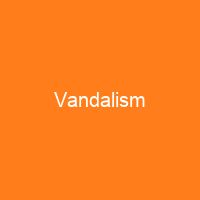Vandalism: The Dark Side of Creativity
Have you ever wondered why some people feel the need to deface public and private property? Vandalism, a term that has its roots in ancient times, is more than just senseless destruction; it’s a complex issue with layers of meaning. Is vandalism merely an act of rebellion or a form of artistic expression?
The Origins of Vandalism
Vandalism was first coined in 1794 to describe the destruction of artwork following the French Revolution, but its roots go back much further. The Vandals, a Germanic tribe known for their destructive ways, sacked Rome in 455 AD, leaving behind a legacy that has shaped our understanding of vandalism ever since.
Vandalism: A Multifaceted Phenomenon
From graffiti to defacement of monuments and cultural works, vandalism can take many forms. It’s not just about breaking things; it’s often an expression of anger, envy, or a desire for attention. Is vandalism always a criminal act, or can it be seen as a form of protest?
The Motives Behind Vandalism
Vandalism is driven by various motives, including peer acceptance, boredom, and feelings of powerlessness. Young people often engage in vandalism because they feel marginalized or misunderstood. Different types of vandalism include acquisitive vandalism, tactical vandalism, ideological vandalism, and play vandalism. Each type reflects a different motive behind the act.
Conventional Strategies vs. Vandalism
Local governments have tried various measures to prevent vandalism, but research suggests that conventional strategies may not be effective. Are we missing something in our approach to combating vandalism?
The Consequences of Vandalism
Vandalism can lead to severe penalties in some countries, such as imprisonment and caning in Singapore or an anti-social behavior order in the UK. The impact of vandalism extends beyond legal consequences; it causes distress and damage to property. As NY Parks Commissioner Henry J. Stern once said, ‘New York City will not be like that,’ referring to the potential for urban decay.
Cybervandalism: The Digital Frontier
With the rise of technology, vandalism has taken on a new form—cybervandalism. This includes website defacement and malware without financial intent. Defacement involves damaging the appearance or surface of something, such as architecture, books, paintings, sculpture, or web sites.
The Fine Line Between Vandalism and Art
There is a fine line between vandalism as an artform, political statement, and crime. Performance art, poetic terrorism, and graffiti are examples of creative expressions that can be seen as forms of vandalism. Norman Mailer glorified the art of vandalism in his essay ‘The Faith of Graffiti’ in 1974, likening tagging in New York City to the work of Giotto and Rauschenberg.
The Legacy of Vandalism
Vandalism has left its mark on history and culture. From Gustave Courbet’s attempt to dismantle the Vendôme column during the 1871 Paris Commune to Banksy’s critique of official vandalism, the act of defacing has been both a symbol of rebellion and an artistic statement.

Vandalism, whether it’s a graffiti tag or the destruction of cultural monuments, is a complex issue that touches on creativity, rebellion, and the human condition. As we continue to grapple with this phenomenon, one thing remains clear: vandalism is not just about breaking things; it’s about expressing something deeper within us.
You want to know more about Vandalism?
This page is based on the article Vandalism published in Wikipedia (retrieved on December 29, 2024) and was automatically summarized using artificial intelligence.







